|
Historical Ephesus Turkey
A personalized private tour is worth the cost
By Lilliam Larsen
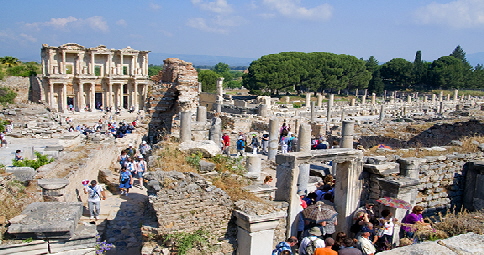 On our recent Mediterranean cruise aboard the Celebrity Solstice, my husband Larry and I had high expectations of our
port visit to Kusadasi, Turkey, and specifically, Ephesus, and we were not disappointed. In fact, our visit exceeded our expectations. We elected to have a half-day Ephesus private guided tour
offered by Pacha Tours (www.pachatours.com) and it proved to be the best shore excursion decision that we made on our
cruise. Upon arrival at the port, our guide and driver were waiting for us. Our drive took us on the famous Arcadian Way, a ceremonial road built during the Hellenistic
Ages that, at one time, had monumental gates. With our private guide, we were able to avoid most of the large bus tour groups and take our time walking through
the ruins. His knowledge of the area was impressive! On our recent Mediterranean cruise aboard the Celebrity Solstice, my husband Larry and I had high expectations of our
port visit to Kusadasi, Turkey, and specifically, Ephesus, and we were not disappointed. In fact, our visit exceeded our expectations. We elected to have a half-day Ephesus private guided tour
offered by Pacha Tours (www.pachatours.com) and it proved to be the best shore excursion decision that we made on our
cruise. Upon arrival at the port, our guide and driver were waiting for us. Our drive took us on the famous Arcadian Way, a ceremonial road built during the Hellenistic
Ages that, at one time, had monumental gates. With our private guide, we were able to avoid most of the large bus tour groups and take our time walking through
the ruins. His knowledge of the area was impressive!
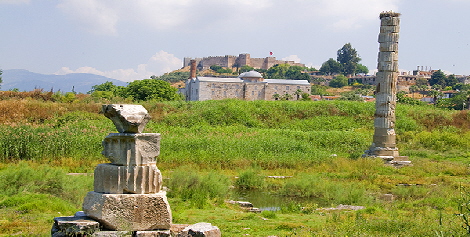 With a complicated history spanning Greeks,
Crusaders, Persians and Romans, Ephesus remains one of the showplaces of Aegean Archeology and history. Ephesus contains the largest collection of Roman ruins in the
eastern Mediterranean, and only an estimated 15% has been excavated. The ruins that are visible give some idea of the city's original splendor, and the names
associated with the ruins are evocative of its former life. The city was famous for the Temple of Artemis (Greeks) or Diana (Romans). One of the Seven Wonders of the
World, this temple is located a few miles away from the Ephesus ruins itself but was part of that entire community. It has been rebuilt at least three times over a site that
was founded in the Bronze Age. Today, only a column of fragmented pieces remains at the location which is mostly flooded. With a complicated history spanning Greeks,
Crusaders, Persians and Romans, Ephesus remains one of the showplaces of Aegean Archeology and history. Ephesus contains the largest collection of Roman ruins in the
eastern Mediterranean, and only an estimated 15% has been excavated. The ruins that are visible give some idea of the city's original splendor, and the names
associated with the ruins are evocative of its former life. The city was famous for the Temple of Artemis (Greeks) or Diana (Romans). One of the Seven Wonders of the
World, this temple is located a few miles away from the Ephesus ruins itself but was part of that entire community. It has been rebuilt at least three times over a site that
was founded in the Bronze Age. Today, only a column of fragmented pieces remains at the location which is mostly flooded.
 More spectacular are the excavations of the city of Ephesus and the famous Library of Celsus, completed in 135 AD. Celsus was one of the earliest men of purely
Greek origin to become a consul in the Roman Empire and is honored both as a Greek and a Roman on the library itself. Celsus paid for the construction of the
library with his own personal wealth and it now serves as his tomb. His sarcophagus is located beneath the library in a crypt. The restoration of the library's fašade is
very impressive and gives visitors a very real image of the size and scope of the library, which stored over 12,000 scrolls. More spectacular are the excavations of the city of Ephesus and the famous Library of Celsus, completed in 135 AD. Celsus was one of the earliest men of purely
Greek origin to become a consul in the Roman Empire and is honored both as a Greek and a Roman on the library itself. Celsus paid for the construction of the
library with his own personal wealth and it now serves as his tomb. His sarcophagus is located beneath the library in a crypt. The restoration of the library's fašade is
very impressive and gives visitors a very real image of the size and scope of the library, which stored over 12,000 scrolls.
In fact, the restoration of several significant buildings throughout the city is the best we've ever seen. With a little
imagination you could feel you were walking through the original city as it was over a thousand years ago. Our feet
walked on the same stone walks that saw the likes of Alexander the Great, the Apostles Paul and John, and many
significant historical figures. The city had one of the most advanced aqueduct systems of their time, with four systems
supplying water through a series of clay pipes that are still visible today. Ephesus also had several major bath complexes built by the Romans.
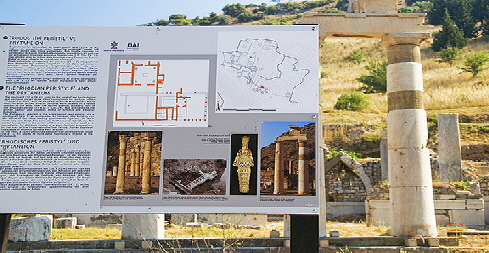 The open-air theater dominates the view down Harbour Street, which leads to the silted-up harbor. The theater is still in
very good condition, and its ability to seat 44,000 spectators made it one of the largest theaters in the ancient world. Built initially for plays, it was also used for
gladiatorial combats during Roman rule. In May 2007 a gladiator graveyard was found within the city. The open-air theater dominates the view down Harbour Street, which leads to the silted-up harbor. The theater is still in
very good condition, and its ability to seat 44,000 spectators made it one of the largest theaters in the ancient world. Built initially for plays, it was also used for
gladiatorial combats during Roman rule. In May 2007 a gladiator graveyard was found within the city.
Ephesus was an important center for Early Christianity from the AD 50s, most notably from the Apostle Paul and his Epistle to the Ephesians found in the New
Testament. The Gospel of John might have been written in Ephesus, c 90–100. Ephesus was one of the seven cities
addressed in Revelation, which indicated that the church at Ephesus was strong.
My husband patiently followed me and our guide as he explained some very interesting aspects of the construction and
architecture of many of the restored buildings. I was truly amazed at how the restorations gave such an impressive
perspective of the magnitude and importance of this city thousands of years ago.
Some of the most significant restoration projects within Ephesus
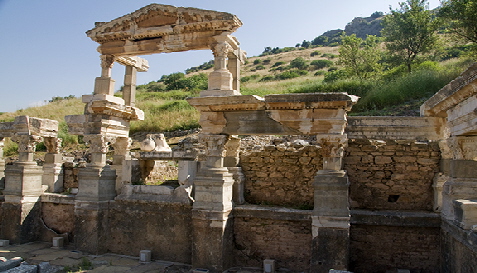 and nearby include the Basilica of and nearby include the Basilica of
St. John built in the 6th century AD over the supposed site of the apostle's tomb; the Odeon, a small roofed theater seating 1
,500 people; the Temple of Hadrian from the 2nd century; the Temple of Domitian, of the largest in the city and depicting intricate carvings of battles and every day
life in Ephesus, and the giant Tomb/Fountain of Pollio erected in 97AD. Many of these sites include informative signs in several languages outlining the
excavation, restoration and the original designs of each.
We spent about three hours walking through the excavations and I could have easily spent another three hours absorbing
the atmosphere of this incredible spot. During our visit, certain areas were blocked
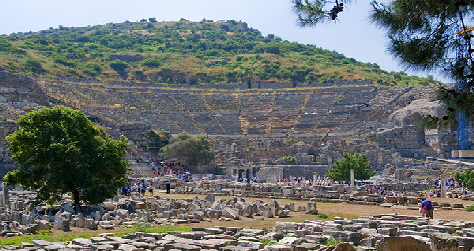 off and covered with temporary roofing as archaeologists continued excavations. I look forward to possibly returning in a few years to see what else is discovered! off and covered with temporary roofing as archaeologists continued excavations. I look forward to possibly returning in a few years to see what else is discovered!
|